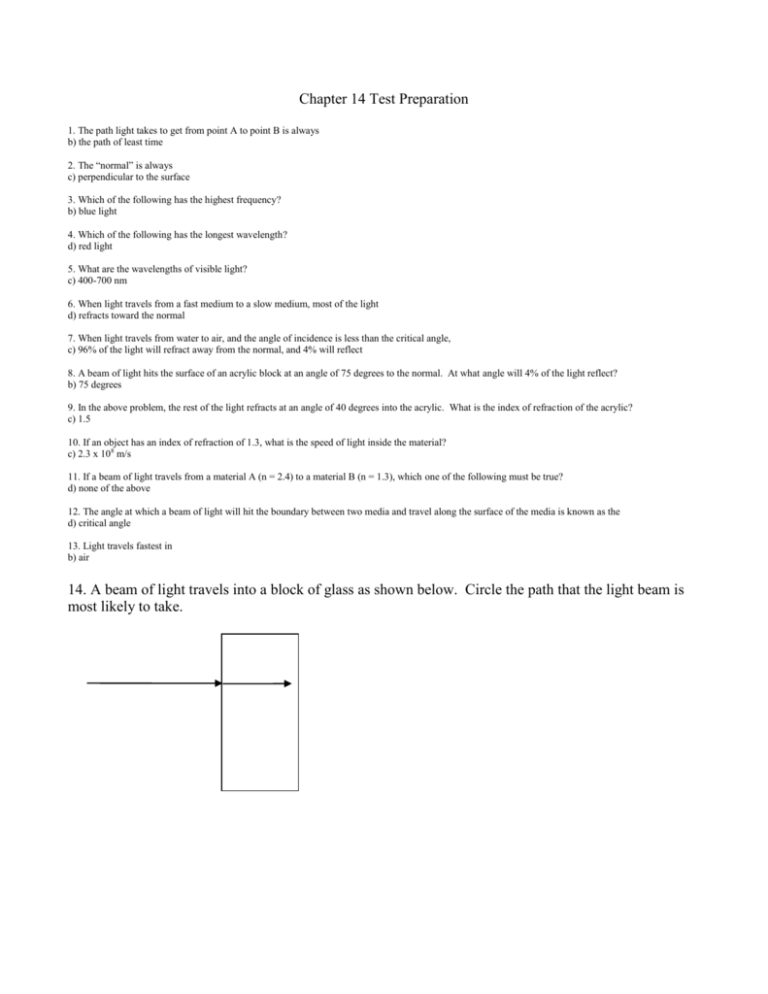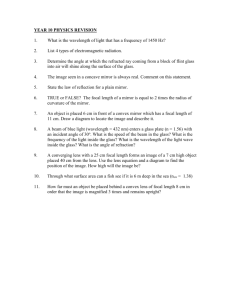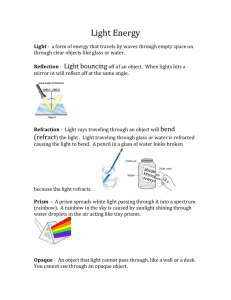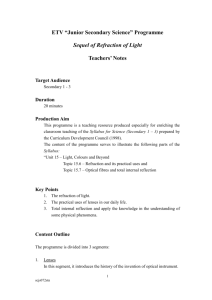Name
advertisement

Chapter 14 Test Preparation 1. The path light takes to get from point A to point B is always b) the path of least time 2. The “normal” is always c) perpendicular to the surface 3. Which of the following has the highest frequency? b) blue light 4. Which of the following has the longest wavelength? d) red light 5. What are the wavelengths of visible light? c) 400-700 nm 6. When light travels from a fast medium to a slow medium, most of the light d) refracts toward the normal 7. When light travels from water to air, and the angle of incidence is less than the critical angle, c) 96% of the light will refract away from the normal, and 4% will reflect 8. A beam of light hits the surface of an acrylic block at an angle of 75 degrees to the normal. At what angle will 4% of the light reflect? b) 75 degrees 9. In the above problem, the rest of the light refracts at an angle of 40 degrees into the acrylic. What is the index of refraction of the acrylic? c) 1.5 10. If an object has an index of refraction of 1.3, what is the speed of light inside the material? c) 2.3 x 108 m/s 11. If a beam of light travels from a material A (n = 2.4) to a material B (n = 1.3), which one of the following must be true? d) none of the above 12. The angle at which a beam of light will hit the boundary between two media and travel along the surface of the media is known as the d) critical angle 13. Light travels fastest in b) air 14. A beam of light travels into a block of glass as shown below. Circle the path that the light beam is most likely to take. 15. A beam of light travels from air into a block of diamond as shown below. Circle the letter of the path that the light will follow after it strikes the upper surface of the diamond. D 16. A beam of light travels from air into a block of glass. If the angle of incidence is 0 degrees, what will happen when the beam enters the glass? c) it will continue traveling along the same path, but at a slower speed 17. What is responsible for the formation of a mirage on a hot day? b) refraction 18. Which color travels the fastest through a glass prism? a) red 19. White light separates into colors when traveling through a glass prism. What is responsible for this effect? b) dispersion 20. Which properties will change when light travels from sapphire into water? I. Frequency II. Wavelength III. Velocity d) II and III. 21. Which is a diverging lens? b) concave 22. Which is a converging lens? a) convex 23. M = -1.25. What kind of lens is it? a) convex (converging) lens 24. M = +1.59. What kind of lens is it? a) convex (converging) lens 25. M = +0.95. What kind of lens is it? d) concave (diverging) lens 26. The image is upright and half the height of the object. Where is the object? a) at the focal point 27. The image is inverted and the same size as the object. Where is the object? b) at the center of curvature IV. Period 1. Draw a ray diagram for this lens: Ray diagram should show an enlarged, upright (virtual) image 2. Draw the path of light through this glass object: 3. At what speed does light travel through a block of sapphire? 1.69 x 108 m/s 4. A beam of light traveling through the air passes into a clear solid as shown below. Using the table, choose the material that this must be: value of “n” material 1.33 water 1.52 crown glass 1.65 flint glass 1.77 sapphire 2.41 diamond 45 23.5 Material = Sapphire (n = 1.77) 5. If the critical angle for ethyl alcohol is 47.3, calculate the index of refraction for ethyl alcohol n = 1.36 1. Concave lenses always produce virtual images. T 2. Convex lenses sometimes produce real images. T 3. A fish looking up at you from the water sees you further away than you really are. T 4. A ray of light incident on a surface is always refracted toward the normal line. F 5. Light travels slower in sapphire than in diamond. F 6. Light has a higher frequency in air than in water. F 7. When using the lens equation, the focal length of concave lenses is positive. T 8. When using the lens equation, the distance to the image is always positive. F 9. All lenses have positive focal lengths. F 10. Putting a concave lens underwater will increase the focal length. T









